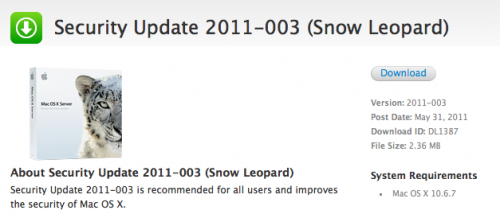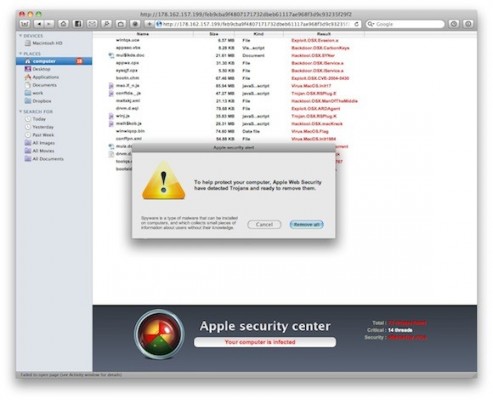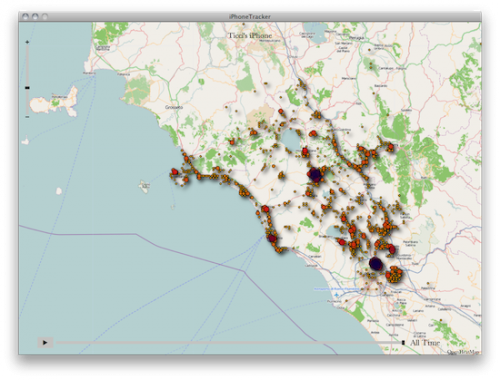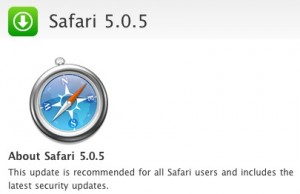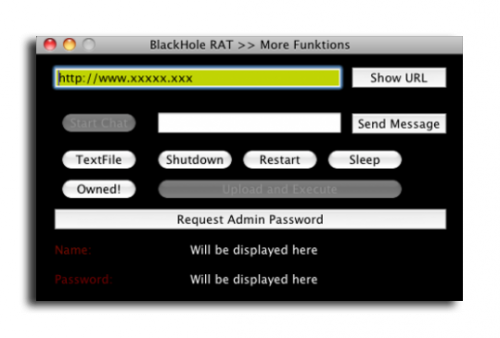News tagged ‘security’
WWDC 2011 liveblog: iOS 5, OS X Lion, iCloud and more!
New Mac Defender Variant Bypasses Apple’s Security Update

Yesterday we reported that Apple had released the Security Update for Snow Leopard users to automatically find and remove the known variants of the Mac Defender malware. Apple enables OS X to update malware definitions daily to make sure that new versions of Mac Defender and other malware software will be discovered and removed. But despite all Apple’s efforts, there was found a new variant of Mac Defender that manages to circumvent Apple’s new security update and work exactly like Mac Defender.
Apple Releases Security Update To Remove Mac Defender
Apple has released a software update that is able to automatically find and remove known variants of the MacDefender malware. The company added a “OSX.MacDefender.A” definition to the malware check and while installation the malware should be find and removed, then users should be notified that the MacDefender is removed.
Apple maintains a list of known malicious software that is used during the safe download check to determine if a file contains malicious software. The list is stored locally, and with Security Update 2011-003 is updated daily by a background process.
New rumors about iPhone 4S и iPhone 5
Macotakara posted some new rumors about upcoming iPhone 4S and iPhone 5 models.
According to an anonymous source, this reported product by DigiTimes is improved model of iPhone 4 on same form factor, and uses ARM Cortex-A9 chip as CPU, but it is not confirmed whether this model has single CPU or with dual CPU's.
They confirmed that the new iPhone (called “iPhone 4S”) will carry ARM Cortex-A9 CPU (A5 chip), however it is unknown whoever it will be single or dual core. The iPhone 4S is said to include the * mega-pixel camera and 3-4 antennas to provide compatibility with both AT&T and Verizon networks. Macotakara revived rumors about sim-less iPhone with built-in chip inside with network settings.
Apple Promises OS X Update to Delete Mac Defender Malware
Apple will release a Mac OS X software update in the next few days that will automatically find, block and remove the popular Mac Defender malware from infected OS X machines.
A recent phishing scam has targeted Mac users by redirecting them from legitimate websites to fake websites which tell them that their computer is infected with a virus. The user is then offered Mac Defender “anti-virus” software to solve the issue. This “anti-virus” software is malware (i.e. malicious software). Its ultimate goal is to get the user’s credit card information which may be used for fraudulent purposes. The most common names for this malware are MacDefender, MacProtector and MacSecurity.
Apple Officially Responds On Location Tracking Issue
After a week of discussions around the discovery that the iPhone has an inbuilt algorithm of keeping track of users' locations in unencrypted file, Apple finally shed light on the subject.
Before we repost the company's , here is a short summary. Apple says it's not tracking the location of iPhone users. It maintains a database of celltowers and Wi-Fi hotspots that allows to calculate your location when requested much more quickly than it can be made with the help of GPS only. The location data is being sent to Apple in anonymous form, and users' iPhones download only the necessary part of the database.
Read the rest of this entry »
Another iPad 2 user: President Barack Obama
As far as we know, President Obama is the most tech-savvy president the United States has ever had. He’s been pictured using Mac during the campaign and now we have had evidence that US President also has the Apple’s iPad 2. Barak Obama was pictured carrying his iPad 2 with the Smart Cover opened that defeats its purpose and may lead to national security repercussions if someone photographed the contents of his home screen. It is quite difficult to figure out whether he has a gray polyurethane Smart Cover or a beige leather one. Nevertheless, the fact that US President is an owner of the iPad 2, is proven.
Researchers Discover iPhone File That Keeps Track Of Your Moves
Alasdair Allan and Pete Warden, security researchers, discovered a file in Apple’s iOS local backup system that keeps track of your location history, in format readable by a computer, and the researchers claim it’s present both on iPhones and iPad 3G units. Such file is kept unencrypted in the iOS database that can be backed up to a computer using iTunes. The researchers have also created an app called iPhoneTracker that recognizes the file from your local iOS backup, and displays your most-visited locations on a map (see the screenshot above). The app is also allows you to encrypt this file.
Apple Releases Safari 5.0.5 and Security Update 2011-002
Alongside release of iOS 4.3.2, Apple also released Safari 5.0.5 and Security Update 2011-002 for Mac OS X. Safari 5.0.5 seems to simply include the latest security updates. The updates are available through Apple's download pages and through Software Update. Security Update 2011-002 is a small download for Snow Leopard users, but the Leopard versions are far and away larger files including even more changes than their Snow Leopard counterparts.
Apple released new firmware iOS 4.3.2
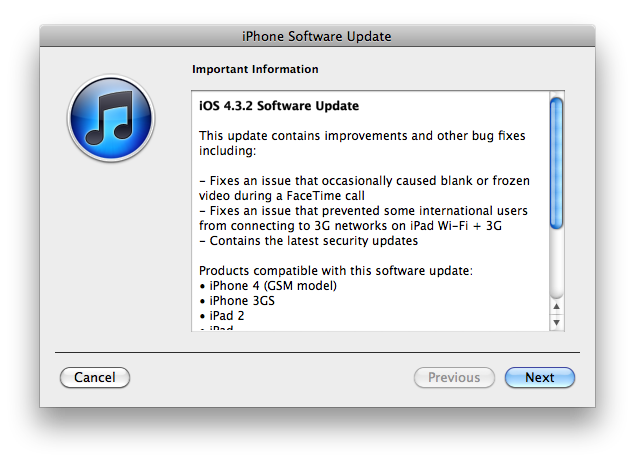
Apple has released iOS 4.3.2 for the iPhone, iPad, and iPod touch.
This update contains improvements and other bug fixes including:
- Fixes an issue that occasionally caused blank or frozen video during a FaceTime call
- Fixes an issue that prvented some international users from connecting to 3G networks on iPad W-Fi + 3G
- Contains the latest security updates
Products compatible with this software update:
- iPhone 4 (GSM model)
- iPhone 3GS
- iPad 2
- iPad
- iPod touch (4th generation)
- iPod touch (3rd generation)
For information on the security content of this update, please visit .
Apple has also updated the firmware for the Verizon iPhone to 4.2.7 although this wasn't listed in the release notes.
Current jailbreak tools work with iOS 4.3.2 in tethered mode only. Please save your SHSH keys for iOS 4.3.1 asap.
Here are direct download links for the latest firmwares:
iOS 4.3.2 will fix Facetime and Verizon iPad 2 issues
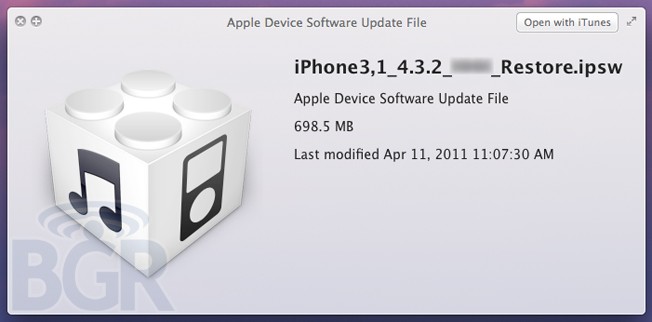
As usual BGR Source has the most recent unreleased iOS. They have recently took a look at 4.3.2 update and it looks like the 3G connections freezing issues on Verizon iPad 2 are fixed:
will fix the issues we’ve been hearing about with some Verizon iPad 2 models. Additionally, the new update is said to contain a fix for FaceTime in addition to security fixes for things like WebKit vulnerabilities and other minor changes.
Office for Mac 2011 Service Pack 1 Coming Next Week
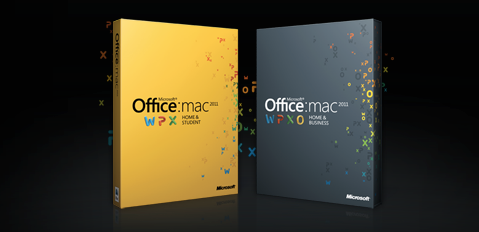
Microsoft is reportedly preparing to release Office for Mac 2011 Service Pack 1 in next week. This major update will bring a number of fixes, some stability and security improvements plus some feature additions. Performance is also receiving a boost in the update. But the most significant new features are said to come in Outlook, including support for syncing calendars to iOS devices via Sync Services.
The update will enable calendar syncing between Outlook for Mac and Apple's Sync Services. This means you can now sync your Outlook calendars, as well as your contacts, notes and tasks with any service or device that supports Sync Services.
Apple released Mac OS X 10.6.7
Apple has released the latest update to the Snow Leopard operating system, Mac OS X 10.6.7. The 10.6.7 Update is recommended for all users running Mac OS X Snow Leopard and includes general operating system fixes that enhance the stability, compatibility, and security of your Mac, including fixes that:
- Improve the reliability of Back to My Mac;
- Resolve an issue when transferring files to certain SMB servers;
- Resolved an issue with mid-2010 MacBook Air kernel panics, AirPort driver issues;
- Improved brightness on external displays;
- Resolved a DVD player playback issue only seen on 64-bit Macs;
- Resolved the issue that could cause users accounts to disappear after the system went to sleep.
Safari 5.0.4 pwned at hacking contest in five seconds
As far as we know, the Apple’s browser Safari was always the subject of intense criticism for its various security weaknesses. A couple of days ago Safari got pwned again at the hacking challenge pwn2own. It took the French team consists of specialists of security firm Vupen just a few seconds to exploit an unpatched Safari vulnerability. “We pwned Apple Safari on Mac OS X (x64) at pwn2own in 5 seconds,” they tweeted. Just a few minutes before the contest, Apple released Safari 5.0.4 alongside iOS 4.3. Vupen said that the update 62 vulnerabilities, breaking “some exploits but not all.” The winners were awarded $15,000 and a MacBook Air. In addition to Safari, Microsoft’s Internet Explorer 8 was also hacked pretty quickly.
New Remote Trojan Targets Growing Number of Mac OS X Users
It seams that malicious hacker put their hands on Mac computers. Security researchers report that hackers have a way to remotely send commands to your Mac OS X computer. “Blackhole” RAT, or Remote Access Trojan, allows hackers to control your Mac. SophosLabs analyzed the sample it received and determined that it is a variant of a well-known Remote Access Trojan (RAT) for Windows known as darkComet. The Blackhole RAT is available for download from the net, but there are no any reports from customers being hit by it.
The Trojan's basic functionality includes:


 Leave a comment
Leave a comment